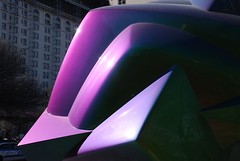Anyway here's the first thing I come back to, in the new issue of Physics News Update (It's a broken link for now -- I get this via email):
STRING THEORY EXPLAINS RHIC JET SUPPRESSION. String theory argues that all matter is composed of string-like shreds in a 10-dimensional hyperspace assembled in various forms. It has won acclaim from many who appreciate the theory’s elegant mathematics and ambition to unite quantum mechanics and general relativity, and skepticism from others who cite the theory’s lack of a practical track record. String theory, the doubters say, makes no testable predictions. But this isn’t exactly true. Indeed, the theory has not yet been experimentally vindicated in the realm of quantum gravity, but has been put into play in the realm of high-energy ion collisions, the kind carried out at Brookhaven’s Relativistic Heavy Ion Collider (RHIC). A few years ago string practitioners attempted to establish a relationship between the 10-dimensional string world and the 4-dimensional (3 spatial dimensions plus time) world in which we observe interactions among quark-filled particles like protons (for background, see Physics Today, May 2005). This duality between string theory and the theory of the strong nuclear force, quantum chromodynamics (QCD), was recently used to interpret puzzling early results from RHIC, namely the suppression of energetic quark jets that should have emerged from the fireball formed when two heavy nuclei (such as gold) collide head on. The thinking was thatperhaps the plasma of quarks and gluons (quarks bursting free from their customary proton and meson groupings) wasn’t a gas of weakly interacting particles (as was originally thought) but a gas of strongly interacting particles, so strong that any energetic quarks that might have escaped the fireball (initiating a secondary avalanche, or jet, or quarks) would quickly be slowed and stripped of energy on its way through the tumultuous quark-gluon plasma (QGP) environment. Two new papers by Hong Liu and Krishna Rajagopal of (MIT) and Urs Wiedemann (CERN) address this problem. The first paper calculates a specific quark-suppression parameter (namely, how much the quarks, each attached to a string dangling "downward" into a fifth dimension, are pushed around as they traverse the quark-gluon plasma) that agrees closely with the experimentally observed value. Rajagopal (krishna@ctp.mit.edu, 617-253-6202) says that in the second paper, the same authors make a specific testable prediction using string theory that bears not just on missing jets of energetic light quarks (up, down, and strange quarks), but on the melting or dissociation temperatures of bound states of heavy quarks (charm-anticharm or bottom-antibottom pairs) moving through the quark-gluon plasma with sufficiently high velocity, as will be produced in future experiments at RHIC and the Large Hadron Collider (LHC) under construction at CERN. (Physical Review Letters: first paper in the 3 November 2006 issue; second paper, upcoming article)Wow that's a long "blurb". No wonder we have such trouble explaining how this all fits together. You have to explain most of modern physics in the same paragraph. Anyway, so we're done (i.e. String Theory Explains RHIC Physics)? I can go home now?
OK, seriously: Nothing brand new (i.e. I heard all of this in China in November) but interesting to see it bubble up to the level of news. While it is nascent phenomenology for now (at least to my eyes/ears), it bodes well for a fascinating future ahead of us. Follow the references and citations of these papers and you'll find a rapidly-growing community of theorists getting in on the action. What do they usually say about exponential growth?...


















